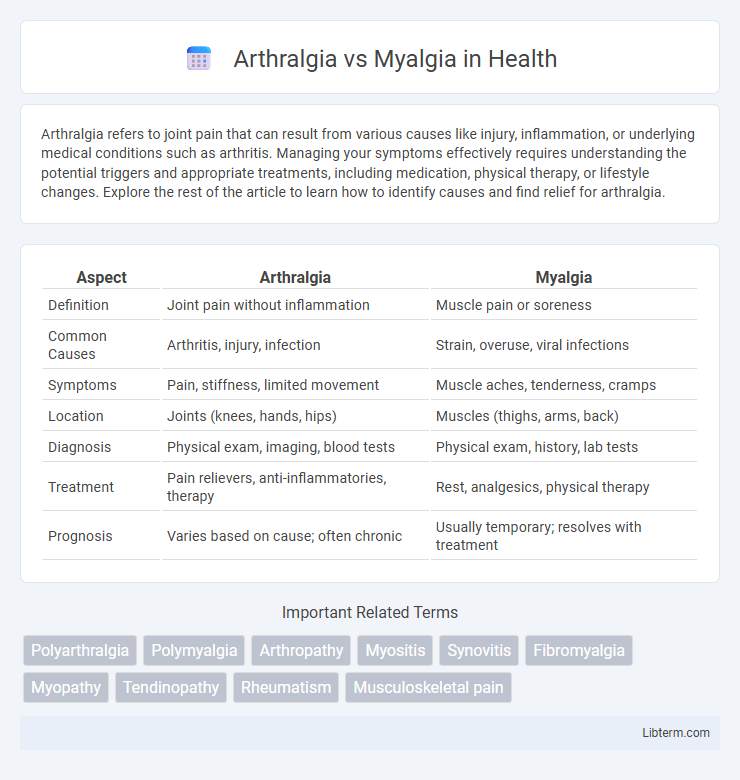Arthralgia refers to joint pain that can result from various causes like injury, inflammation, or underlying medical conditions such as arthritis. Managing your symptoms effectively requires understanding the potential triggers and appropriate treatments, including medication, physical therapy, or lifestyle changes. Explore the rest of the article to learn how to identify causes and find relief for arthralgia.
Table of Comparison
| Aspect | Arthralgia | Myalgia |
|---|---|---|
| Definition | Joint pain without inflammation | Muscle pain or soreness |
| Common Causes | Arthritis, injury, infection | Strain, overuse, viral infections |
| Symptoms | Pain, stiffness, limited movement | Muscle aches, tenderness, cramps |
| Location | Joints (knees, hands, hips) | Muscles (thighs, arms, back) |
| Diagnosis | Physical exam, imaging, blood tests | Physical exam, history, lab tests |
| Treatment | Pain relievers, anti-inflammatories, therapy | Rest, analgesics, physical therapy |
| Prognosis | Varies based on cause; often chronic | Usually temporary; resolves with treatment |
Introduction to Arthralgia and Myalgia
Arthralgia refers to joint pain without inflammation, commonly affecting knees, shoulders, and fingers, while myalgia denotes muscle pain that can result from strain, injury, or systemic conditions like viral infections. Both conditions present with discomfort but differ in origin; arthralgia involves joints, and myalgia involves muscle tissue. Accurate diagnosis relies on clinical evaluation and may require imaging or laboratory tests to distinguish between musculoskeletal and inflammatory causes.
Defining Arthralgia: Joint Pain Explained
Arthralgia refers specifically to pain localized in one or more joints without inflammation, differentiating it from myalgia, which is muscle pain. Common causes of arthralgia include osteoarthritis, rheumatoid arthritis, and injury, with symptoms presenting as aching, stiffness, or sharp joint pain. Accurate diagnosis often requires clinical evaluation and imaging to distinguish between joint vs muscle pain sources for effective treatment.
Understanding Myalgia: Muscle Pain Overview
Myalgia refers to muscle pain caused by strain, injury, infection, or inflammation, often presenting as soreness or stiffness. It differs from arthralgia, which is joint pain without muscle involvement, typically linked to arthritis or joint conditions. Effective diagnosis of myalgia involves evaluating factors like muscle tenderness, weakness, and associated systemic symptoms to determine underlying causes.
Causes of Arthralgia vs Myalgia
Arthralgia primarily arises from joint-related causes such as osteoarthritis, rheumatoid arthritis, gout, or injury, involving inflammation or damage to cartilage, synovium, or bone. Myalgia is typically caused by muscle strain, overuse, viral infections, metabolic disorders, or medication side effects that directly affect muscle tissue. Differentiating these underlying causes is essential for accurate diagnosis and targeted treatment strategies.
Common Symptoms: Arthralgia vs Myalgia
Arthralgia presents as joint pain characterized by stiffness, swelling, and limited range of motion without inflammation, whereas myalgia involves muscle pain often described as soreness, cramping, or tightness. Both arthralgia and myalgia can cause discomfort and reduced mobility, but arthralgia affects joints specifically, while myalgia targets muscle tissues. Differentiating symptoms such as joint swelling in arthralgia versus muscle tenderness in myalgia helps guide accurate diagnosis and treatment.
Key Differences Between Arthralgia and Myalgia
Arthralgia refers to joint pain without inflammation, often linked to conditions like arthritis or injury, while myalgia specifically denotes muscle pain caused by strain, infection, or systemic illness. Key differences include the location of pain--arthralgia affects joints, whereas myalgia impacts muscles--and the presence of associated symptoms such as swelling in arthralgia versus muscle tenderness or spasms in myalgia. Diagnostic approaches also differ; arthralgia requires joint assessment through imaging and blood tests for autoimmune markers, whereas myalgia evaluation may focus on muscle enzymes and viral serology.
Diagnostic Approaches for Arthralgia and Myalgia
Diagnostic approaches for arthralgia involve detailed joint examinations, imaging techniques such as X-rays, MRI, or ultrasound, and laboratory tests including rheumatoid factor and anti-CCP antibodies to identify underlying conditions like arthritis. Myalgia diagnosis emphasizes muscle strength assessment, electromyography (EMG), muscle enzyme evaluation such as creatine kinase levels, and consideration of systemic causes like viral infections or polymyositis. Differentiating between arthralgia and myalgia relies on clinical history, physical findings, and targeted diagnostic testing to accurately determine joint inflammation versus muscle pathology.
Treatment Options for Arthralgia and Myalgia
Treatment options for arthralgia primarily include nonsteroidal anti-inflammatory drugs (NSAIDs), corticosteroid injections, and physical therapy to reduce joint pain and inflammation. Myalgia management often involves analgesics, muscle relaxants, and targeted exercises to alleviate muscle soreness and improve mobility. Both conditions benefit from patient-specific treatment plans aiming to address underlying causes and enhance quality of life.
Prevention and Management Strategies
Arthralgia prevention includes maintaining joint health through regular low-impact exercise, weight management, and avoiding repetitive joint stress. Myalgia management emphasizes adequate hydration, balanced nutrition, and proper warm-up routines before physical activities to reduce muscle strain. Both conditions benefit from early diagnosis, appropriate medication, physical therapy, and lifestyle modifications to minimize pain and improve mobility.
When to Seek Medical Attention
Persistent joint pain accompanied by swelling, redness, or inability to move the affected area warrants immediate medical evaluation to rule out conditions like arthritis or infection. Severe muscle pain, especially if associated with weakness, dark urine, or fever, requires prompt attention to diagnose possible rhabdomyolysis or systemic illness. Sudden onset of either arthralgia or myalgia following trauma or infection should be assessed by a healthcare professional to prevent complications.
Arthralgia Infographic

 libterm.com
libterm.com